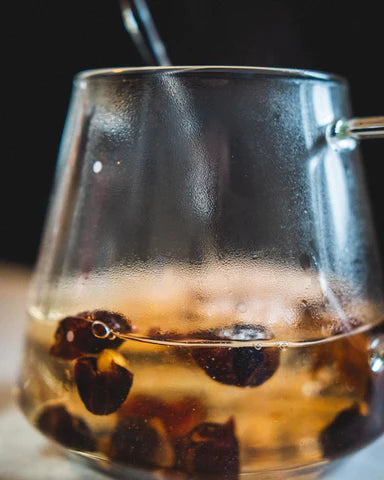Is cascara the new black? Let’s examine how this game-changing super-tea is shaking up the coffee world!

Cascara Meaning
Cascara is a direct translation of the Spanish word for “husk” or “shell”. The coffee bean that we’ve all grown to know and love is technically the seed of the coffee cherry, which grows a fleshy, juicy fruit around it. When coffee is being processed, the fruit shell usually gets discarded, and the coffee beans are dried and roasted to the form we see when we open up our monthly bag of coffee!
To understand this better, here’s a breakdown about the anatomy of a coffee cherry:
Outer Skin: Also known as the exocarp, the outer layer is thick and slightly bitter. It starts as green until it ripens to that renowned, shiny red colour, (or yellow, or orange, or even pink depending on variety!)
Pulp: The first sugary layer of the fruit directly beneath the skin. Also known as mesocarp, it has a texture likened to that of a grape.
Mucilage: The inner layer of the pulp, which is thin and slippery and covers the parchment. Very important for the coffee fermentation process!
Parchment: The endocarp, a protective layer of the coffee bean and silverskin.
Silverskin: A group of sclerenchyma cells that coat the bean to protect it. They usually come off during roasting, where they are known as chaff.
Cascara includes the outer skin and the pulp, which used to be seen as a byproduct of coffee processing. Recently, cascara farming has taken on a whole life of its own!
How Cascara is Made
To make cascara, coffee is first de-pulped, and the cherry skins are collected and washed. They are either cleansed through water, or they go through a vaporized chamber that rapidly heats them, killing any potential bacteria. After the skins are washed, they can then start the drying process. Traditionally cascara is dried in the sun, but some farms will put them in a large dehydrator before preparing for export.
Oftentimes, cascara is an afterthought, but recently, some farms have dedicated more time and energy to the cascara-making process.
For example, This Cascara was grown on a lot designed specifically for cascara! In Llano Bonito de Naranjo, Costa Rica, Ricardo Pérez and brothers Felipe and Marvin Rodriguez decided to focus their efforts on creating high-quality cascara. They produced this tea in Costa Rica at their Helsar de Zarcero Micromill using modern technology, pasteurization, and specialization. Since 2012, the University of Costa Rica and the team at the Micromill have been researching the possibility of creating a food-grade cascara. The coffees used here belong to the Caturra, Catuai, and Villalobos variety, and were chosen specifically to grow the best tea!

How to Use Cascara
The main way to use cascara is through brewing tea. Coffee-cherry tea has been popularized recently as a lower-caffeine alternative to coffee, with a more unique flavour profile than tea. Despite this, cascara is technically neither coffee nor tea, though carries more resemblance to the latter flavour-wise.
The easiest way to enjoy it is to brew it with a french press. With a ratio of 25g of water for 1g of the tea, pour boiled water over the cascara, wait for 4 minutes, stir then plunge.
You can also use a Chemex to brew cascara, and we wrote a whole brew guide for it.
Other Ideas:
- Pour over ice and add honey for a refreshing and delicious summer ice tea.
- Make fancy cocktails like this Husker Dew!
- Add to your baked goods (we made delicious cascara muffins with them!)

What Does Cascara Taste Like?
Despite stemming from the coffee plant (quite literally), cascara tastes nothing like coffee. It has honey and floral notes you might get from a fruity tea since you brew the dried fruit whole. It is also dependent on the variety of the coffee cherry, where it’s grown, the altitude and the processing method, but most types of cascara have a sweet, sugary base note, with flavours of prune, raspberry, and golden raisin present. Anticipate an unexpected cherry-like sweetness when taking your first sip!
How Much Caffeine is in Cascara?
While originating from the coffee plant, cascara has about a quarter of the caffeine levels compared to regular brew. One study found out that cascara tea has around 25mg of caffeine per cup (compared to 80mg of caffeine per cup of coffee), no matter how long the steeping time is. Compared to black tea which rests at around 50mg of caffeine per cup, cascara compares best with green tea which also has around 25mg of caffeine per cup.
Cascara Health Benefits
Aside from being flavourful and delicious, cascara is jam-packed with antioxidants! Not to be confused with Cascara Sagrada, a natural laxative stemming from tree bark, coffee-plant cascara is high in phenolic compounds, which play a significant role in the prevention of many chronic diseases due to their antioxidant, anti-inflammatory and anti-carcinogenic properties.
Additionally, the same flavonoids that are found in dark chocolate are also abundant in cascara, which might promote a similar benefit to cardiovascular health (cascara-infused dark chocolate anyone?). However, unlike chocolate, cascara has virtually no fat, cholesterol, sugar or sodium with very few calories, and doesn’t cause the same jitters that coffee does!
To Summarize
While we’re coffee lovers at heart, there’s a new sheriff in town, and its name is cascara! Thirsty for more? Follow us on Instagram @theroasterspack for more information about everything coffee!





